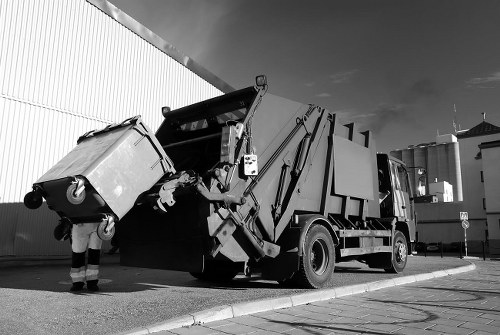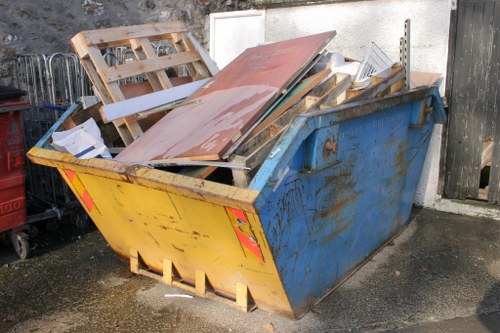Comprehensive Guide to Demolition Waste Removal in Upminster

Understanding Demolition Waste
Demolition waste encompasses a wide range of materials generated during the demolition of buildings and structures. This includes concrete, wood, metals, glass, and hazardous materials such as asbestos. Proper management and removal of demolition waste are crucial to ensure environmental safety and compliance with local regulations.
In Upminster, the increasing number of construction and demolition projects has heightened the need for efficient waste removal solutions. Effective demolition waste removal not only aids in maintaining cleanliness but also promotes recycling and sustainable practices.
Whether you are a homeowner planning to renovate or a contractor handling large-scale demolitions, understanding the process and benefits of demolition waste removal is essential.

Benefits of Professional Demolition Waste Removal
Opting for professional demolition waste removal services in Upminster offers numerous advantages:
- Environmental Protection: Professionals ensure that hazardous materials are handled and disposed of safely, minimizing environmental impact.
- Compliance: Adhering to local regulations and obtaining necessary permits is streamlined when you work with experts.
- Efficiency: Experienced teams can complete waste removal swiftly, reducing project delays.
- Cost-Effective: Proper waste management prevents potential fines and reduces the need for additional labor.
These benefits highlight the importance of choosing the right demolition waste removal service to ensure a smooth and responsible demolition process.

Steps Involved in Demolition Waste Removal
1. Assessment and Planning
The initial step involves assessing the demolition site to identify the types and quantities of waste materials. This assessment helps in planning the removal process effectively.
2. Sorting and Segregation
Waste materials are sorted and segregated based on their nature. Recyclable materials like metals and certain plastics are separated to promote recycling.
3. Safe Removal
Professionals use specialized equipment to safely remove waste, ensuring that hazardous materials are handled with care.
4. Transportation
The sorted waste is transported to designated recycling centers or disposal facilities, adhering to environmental guidelines.

Recycling and Sustainability
Recycling demolition waste plays a pivotal role in promoting sustainability. Materials like metal, wood, and concrete can be repurposed, reducing the demand for new resources.
In Upminster, recycling centers are equipped to handle various demolition materials, ensuring that as much waste as possible is diverted from landfills.
Embracing recycling not only conserves resources but also lowers the overall carbon footprint of construction and demolition activities.

Choosing the Right Demolition Waste Removal Service
Selecting a reliable and experienced waste removal service is crucial for the success of your demolition project. Consider the following factors:
- Experience and Expertise: Ensure the company has a proven track record in handling various types of demolition waste.
- Licensing and Certification: Verify that the service provider holds the necessary licenses and adheres to regulatory standards.
- Recycling Practices: Choose a company committed to recycling and minimizing environmental impact.
- Customer Reviews: Positive feedback and testimonials can provide insights into the company's reliability and quality of service.
- Transparent Pricing: A reputable service should offer clear and competitive pricing without hidden fees.
Taking these factors into account will help you partner with a service that meets your specific demolition waste removal needs.
Local Regulations and Compliance
Compliance with local regulations is mandatory when it comes to demolition waste removal in Upminster. Authorities have set guidelines to ensure that waste is handled responsibly and that environmental standards are maintained.
Key regulations include:
- Waste Disposal Permits: Obtaining necessary permits before commencing demolition activities.
- Hazardous Material Handling: Proper procedures for the removal and disposal of hazardous substances like asbestos.
- Recycling Requirements: Mandatory sorting of recyclable materials to encourage environmental sustainability.
Working with a professional demolition waste removal service ensures that all regulatory requirements are met, avoiding potential legal issues and fines.
Cost Factors in Demolition Waste Removal
The cost of demolition waste removal can vary based on several factors:
- Volume of Waste: Larger projects generate more waste, impacting the overall cost.
- Type of Materials: Hazardous and non-recyclable materials may require specialized handling, increasing expenses.
- Accessibility: Difficult-to-access sites may necessitate additional labor and equipment.
- Geographical Location: Services in certain areas of Upminster might have varying pricing structures.
- Service Level: Comprehensive services that include sorting, recycling, and disposal may cost more but offer added convenience.
Understanding these cost factors helps in budgeting appropriately for your demolition project and selecting a service that offers the best value for your needs.
Environmental Impact of Improper Waste Removal
Neglecting proper demolition waste removal can have severe environmental consequences:
- Pollution: Improper disposal can lead to soil and water contamination.
- Resource Wastage: Valuable materials end up in landfills instead of being recycled.
- Health Risks: Exposure to hazardous materials poses significant health hazards to workers and the community.
- Legal Repercussions: Non-compliance with waste management regulations can result in hefty fines and legal issues.
Ensuring proper waste removal mitigates these risks, promoting a healthier and more sustainable environment.
Innovative Waste Removal Technologies
The demolition waste removal industry is continually evolving with innovative technologies that enhance efficiency and sustainability:
- Advanced Sorting Systems: Automated systems that accurately separate different types of materials.
- Recycling Machinery: Equipment designed to process and recycle various demolition materials effectively.
- Green Disposal Methods: Environmentally friendly disposal techniques that minimize carbon footprint.
- Digital Tracking: Software solutions that track waste from removal to final disposal, ensuring transparency and compliance.
Adopting these technologies enables waste removal services in Upminster to provide superior and eco-friendly solutions to their clients.
Case Studies: Successful Waste Removal Projects in Upminster
Examining successful demolition waste removal projects in Upminster provides valuable insights into best practices and effective strategies:
Project A: Residential Complex Demolition
A large residential complex was demolished with a focus on maximizing material recycling. The waste removal team employed advanced sorting techniques, successfully diverting 80% of the waste from landfills.
Project B: Commercial Building Renovation
During the renovation of a commercial building, the waste removal service effectively managed hazardous materials, ensuring the safety of workers and compliance with environmental regulations.
Project C: Industrial Facility Upgrade
An industrial facility upgrade required meticulous waste management. The removal team utilized digital tracking to monitor waste disposal, enhancing transparency and operational efficiency.
These case studies demonstrate the importance of professional waste removal services in achieving successful and sustainable demolition projects.
Future Trends in Demolition Waste Removal
The future of demolition waste removal is poised for significant advancements, driven by the growing emphasis on sustainability and technological innovation:
- Circular Economy Integration: Emphasizing the reuse and recycling of materials to create a closed-loop system.
- Automation and AI: Utilizing artificial intelligence and robotics to enhance sorting accuracy and operational efficiency.
- Green Certifications: Increasing demand for services that meet stringent environmental standards and certifications.
- Community Engagement: Encouraging community involvement in sustainability initiatives related to demolition projects.
- Enhanced Data Analytics: Leveraging data to optimize waste management processes and improve decision-making.
Staying abreast of these trends will enable demolition waste removal services in Upminster to offer innovative and sustainable solutions to their clients.
DIY vs. Professional Demolition Waste Removal
While some may consider handling demolition waste removal independently, there are compelling reasons to opt for professional services:
Advantages of DIY Removal
- Cost Savings: Potentially lower immediate costs by handling removal independently.
- Control: Direct oversight of the removal process.
Disadvantages of DIY Removal
- Safety Risks: Increased risk of accidents and exposure to hazardous materials.
- Regulatory Compliance: Challenges in adhering to local waste management regulations.
- Time-Consuming: Significant time investment required for effective removal and disposal.
- Limited Recycling: Reduced ability to recycle materials efficiently.
Given these factors, professional demolition waste removal services offer a safer, more efficient, and compliant approach to managing demolition debris.
Environmental Certifications and Standards
Adhering to environmental certifications and standards is essential for demolition waste removal services aiming to demonstrate their commitment to sustainability:
- ISO 14001: International standard for environmental management systems.
- Waste Management Certifications: Accreditation from recognized bodies ensuring proper waste handling and disposal.
- Local Environmental Standards: Compliance with Upminster-specific regulations and guidelines.
These certifications not only enhance the credibility of waste removal services but also assure clients of their dedication to environmentally responsible practices.
Impact on Local Community
Effective demolition waste removal positively impacts the local community in Upminster:
- Cleaner Environment: Reduced waste and pollution contribute to a healthier living space.
- Job Creation: Waste removal services create employment opportunities within the community.
- Economic Benefits: Recycling and efficient waste management support local businesses and sustainability initiatives.
- Public Health: Proper handling of hazardous materials prevents health hazards and promotes overall well-being.
By prioritizing responsible waste removal, services contribute to the prosperity and sustainability of the Upminster community.
Tips for Effective Demolition Waste Management
Implementing effective waste management strategies can streamline the demolition process and enhance sustainability:
- Plan Ahead: Develop a comprehensive waste management plan before starting the demolition.
- Sort Materials: Segregate waste on-site to facilitate recycling and proper disposal.
- Partner with Recyclers: Collaborate with local recycling facilities to maximize material reuse.
- Monitor Compliance: Regularly check adherence to environmental regulations and standards.
- Educate Teams: Train workers on best practices for waste handling and safety.
These tips can significantly improve the efficiency and environmental impact of your demolition projects.
Call to Action
Ready to undertake your demolition project in Upminster? Ensure it's handled responsibly and efficiently with our professional demolition waste removal services. Contact us today to learn more and schedule your service.